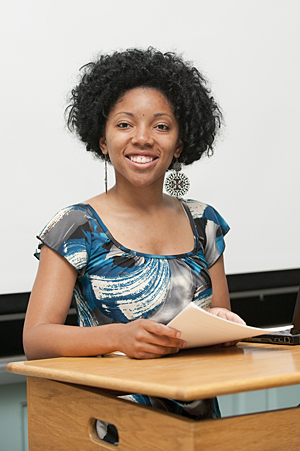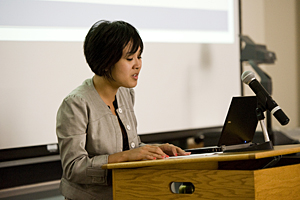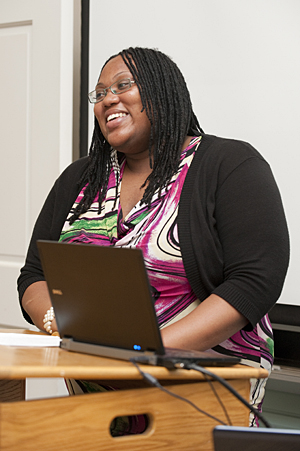ADVERTISEMENT
- Rozovsky wins prestigious NSF Early Career Award
- UD students meet alumni, experience 'closing bell' at NYSE
- Newark Police seek assistance in identifying suspects in robbery
- Rivlin says bipartisan budget action, stronger budget rules key to reversing debt
- Stink bugs shouldn't pose problem until late summer
- Gao to honor Placido Domingo in Washington performance
- Adopt-A-Highway project keeps Lewes road clean
- WVUD's Radiothon fundraiser runs April 1-10
- W.D. Snodgrass Symposium to honor Pulitzer winner
- New guide helps cancer patients manage symptoms
- UD in the News, March 25, 2011
- For the Record, March 25, 2011
- Public opinion expert discusses world views of U.S. in Global Agenda series
- Congressional delegation, dean laud Center for Community Research and Service program
- Center for Political Communication sets symposium on politics, entertainment
- Students work to raise funds, awareness of domestic violence
- Equestrian team wins regional championship in Western riding
- Markell, Harker stress importance of agriculture to Delaware's economy
- Carol A. Ammon MBA Case Competition winners announced
- Prof presents blood-clotting studies at Gordon Research Conference
- Sexual Assault Awareness Month events, programs announced
- Stay connected with Sea Grant, CEOE e-newsletter
- A message to UD regarding the tragedy in Japan
- More News >>
- March 31-May 14: REP stages Neil Simon's 'The Good Doctor'
- April 2: Newark plans annual 'wine and dine'
- April 5: Expert perspective on U.S. health care
- April 5: Comedian Ace Guillen to visit Scrounge
- April 6, May 4: School of Nursing sponsors research lecture series
- April 6-May 4: Confucius Institute presents Chinese Film Series on Wednesdays
- April 6: IPCC's Pachauri to discuss sustainable development in DENIN Dialogue Series
- April 7: 'WVUDstock' radiothon concert announced
- April 8: English Language Institute presents 'Arts in Translation'
- April 9: Green and Healthy Living Expo planned at The Bob
- April 9: Center for Political Communication to host Onion editor
- April 10: Alumni Easter Egg-stravaganza planned
- April 11: CDS session to focus on visual assistive technologies
- April 12: T.J. Stiles to speak at UDLA annual dinner
- April 15, 16: Annual UD push lawnmower tune-up scheduled
- April 15, 16: Master Players series presents iMusic 4, China Magpie
- April 15, 16: Delaware Symphony, UD chorus to perform Mahler work
- April 18: Former NFL Coach Bill Cowher featured in UD Speaks
- April 21-24: Sesame Street Live brings Elmo and friends to The Bob
- April 30: Save the date for Ag Day 2011 at UD
- April 30: Symposium to consider 'Frontiers at the Chemistry-Biology Interface'
- April 30-May 1: Relay for Life set at Delaware Field House
- May 4: Delaware Membrane Protein Symposium announced
- May 5: Northwestern University's Leon Keer to deliver Kerr lecture
- May 7: Women's volleyball team to host second annual Spring Fling
- Through May 3: SPPA announces speakers for 10th annual lecture series
- Through May 4: Global Agenda sees U.S. through others' eyes; World Bank president to speak
- Through May 4: 'Research on Race, Ethnicity, Culture' topic of series
- Through May 9: Black American Studies announces lecture series
- Through May 11: 'Challenges in Jewish Culture' lecture series announced
- Through May 11: Area Studies research featured in speaker series
- Through June 5: 'Andy Warhol: Behind the Camera' on view in Old College Gallery
- Through July 15: 'Bodyscapes' on view at Mechanical Hall Gallery
- More What's Happening >>
- UD calendar >>
- Middle States evaluation team on campus April 5
- Phipps named HR Liaison of the Quarter
- Senior wins iPad for participating in assessment study
- April 19: Procurement Services schedules information sessions
- UD Bookstore announces spring break hours
- HealthyU Wellness Program encourages employees to 'Step into Spring'
- April 8-29: Faculty roundtable series considers student engagement
- GRE is changing; learn more at April 15 info session
- April 30: UD Evening with Blue Rocks set for employees
- Morris Library to be open 24/7 during final exams
- More Campus FYI >>
9:35 a.m., July 8, 2010----Six undergraduate students from across the nation recently completed the third annual University of Delaware Arts and Humanities Summer Institute (AHSI) by sharing the results of their research on novels exploring issues of race and gender in American society during the 19th and 20th centuries.
The research presentations were made to faculty and members of the UD community during a daylong research symposium held June 29 in Memorial Hall.
The Arts and Humanities Summer Institute ran from June 6 through July 2 and included class discussions, student research, guest lecturers and workshops.
Rosalind Johnson, AHSI director, said “the research of these students was exhaustive.” Martin Brueckner, associate professor of English, and AHSI co-faculty adviser, congratulated participants for their research efforts and preparation for possible graduate school careers.
Timothy Spaulding, AHSI faculty co-adviser and associate professor of English and Black American Studies, noted that the students' research efforts examined three novels from a variety of critical perspectives. The novels were Clotel; or, The President's Daughter (1853) by William Wells Brown, Passing (1929) by Nella Larsen, and The Bluest Eye (1970) by Toni Morrison (1970).
Shannon Pratt of Francis Marion University in South Carolina examined Brown's novel though her research presentation, “Cross-dressing and Gender as Performance in William Wells Brown's Clotel.”
Published in London and written by a fugitive from slavery and an abolitionist spokesman, Clotel has been considered the first African-American novel.
“Upon reading William Wells Brown's Clotel, I noticed that there were several episodes in the text in which characters disguised themselves as the opposite sex,” Pratt said. “I found these occurrences interesting, but I was confused as to what their purpose was in a novel that otherwise was about racial differences and slavery.”
Pratt noted that while the entire framework of American society at the time was being challenged by these acts of racial and gender cross-dressing, Brown still believed in the importance of maintaining established gender lines.
“It occurred to me that Brown's poignant addition of minstrel shows questioning racial differences and relating the accounts of slaves were all about challenging society's beliefs of race and slavery,” Pratt said. “In the midst of all of this he accidentally challenged society's beliefs about gender, as well.”
Morrison's first novel was the focus of “Blonde Hair, Blue Eyes, Black Skin” presented by Tazia Shorter of Tennessee State University.
The Bluest Eye, set in Morrison's birthplace of Lorain, Ohio, focuses on the tragic psychological devastation of Pecola Breedlove, a young African American girl who sought to attain the ideal American standard of feminine beauty as reflected in the popular American culture of the time.
This standard of female beauty also became an obsession of Pecola's mother, Pauline Breedlove, who sought escape from the realities of her everyday life as an African American woman by watching the movies of blonde-haired film stars like Jean Harlow. Pauline later sought the same kind of release through religion.
“Pauline Breedlove is a victim of what she can't have, and is willing to drive her family crazy because of it,” Shorter said. “She is insecure with who she is, unhappy with her marriage, and she fails to realize that the white woman she aspires to be doesn't exist.”
Other presentations included:
“Whose House is it Anyway? The Fall of the House in Toni Morrison's The Bluest Eye,” by Debbie Nguyen of Swarthmore College;
“Defying the 'Norms': The Construction of the Literary Free Jazz Ensemble in Toni Morrison's The Bluest Eye,” by Tempestt Gavins of Columbia College;
“The Un/Mothering of Pecola Breedlove in The Bluest Eye,” by Patricia Abrahams of Syracuse University; and
“Cinema and Christianity as Outlets for Communal Self-Deception in The Bluest Eye,” by Staci Poston of Francis Marion University.
Article by Jerry Rhodes
Photos by Kathy F. Atkinson and Evan Krape





